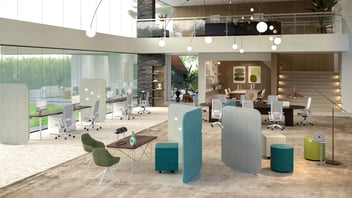Exploring the Future: Coworking Trends in 2024
In this post, we will delve into the exciting business world, exploring Coworking Trends in 2024 and their impact on professional communities, reshaping the way we collaborate today.
.webp?width=1200&height=700&name=tendencias-coworking-coworkin-trends-2024%20(1).webp)
Professional communities act as the connective tissue that brings together individuals with diverse skills and unique experiences. In this scenario, coworking has emerged as a transformative force, redefining how we work together, and its landscape is marked by new trends shaping the future of work.
Coworking Trends in 2024
Hybrid Coworking:
What is hybrid coworking? It is the response to the growing need for flexibility in work. This trend combines the freedom of remote work with the structure and collaboration of a coworking space, offering an ideal balance.
.webp?width=1200&height=700&name=coworking-hibrido%20(1).webp)
In hybrid coworking, workers can choose where and when to work according to their needs and preferences. Some days they can work from home, while on other days, they can work in a coworking space. This provides several advantages for workers, in addition to flexibility at work:
- Collaboration: Coworking spaces provide a collaborative environment that can help workers connect with other professionals and collaborate on projects.
- Productivity: Coworking can help workers be more productive by offering a comfortable and well-equipped environment.
Hybrid coworking also offers advantages for companies, including:
- Cost reduction: It can help companies cut office costs by providing flexible and affordable workspace.
- Talent attraction and retention: Coworking can help companies attract and retain talent by offering a flexible and collaborative work environment.
Sustainable Coworking
Environmental awareness is driving the trend of sustainable coworking. Coworking spaces seek to reduce their ecological footprint by adopting environmentally friendly practices and fostering a culture of sustainability. This trend is growing due to increased awareness of climate change.
These spaces adopt various practices to reduce their environmental impact, including:
- Use of sustainable materials: For example, they may use certified wood, recycled materials, or locally sourced materials.
- Energy efficiency: Sustainable coworking spaces use efficient lighting and heating systems to reduce energy consumption. They may also use energy-saving technologies such as motion sensors or lighting management systems.
- Waste reduction: Sustainable coworking spaces take measures to reduce waste generation. For instance, they may offer recycling and composting programs or use reusable materials.
- Sustainable transportation: Sustainable coworking spaces may promote the use of eco-friendly transportation, such as public transport or bicycles. They may offer discounts for public transportation or provide facilities for bike storage.
The main advantage of the sustainable coworking trend is that any existing collaborative space can incorporate it and benefit from various advantages, including:
- Cost reduction: Sustainability measures can help reduce energy and water costs, among others.
- Improved image: Sustainable coworking spaces can enhance their image and attract customers and workers who share their values.
- Contribution to climate change mitigation: Sustainable coworking spaces can contribute to reducing environmental impact and combating climate change.
Inclusive Coworking
Diversity is the key to inclusive coworking. In 2023, we witnessed a shift towards spaces that celebrate diversity in all its forms, and this trend will continue in 2024, creating welcoming and accessible environments for everyone.
Inclusive coworking spaces are shared workspaces designed to be accessible to everyone, regardless of their background, race, gender, sexual orientation, disability, etc. This is another trend that can (and should) be incorporated into existing workspaces, with measures such as the following examples:
- Accessible spaces for people with disabilities. This includes ramps, elevators, adapted workstations with adjustable height, accessibility software, interpretation services, and accessible bathrooms.
- Affordable prices. Inclusive coworking spaces should offer affordable prices for people from all backgrounds or opt for different membership options, including more accessible ones.
- Support programs. Inclusive coworking spaces can offer support programs to help individuals facing specific challenges, such as mentoring programs for women or training programs for people with disabilities.
- Promotion of a welcoming, respectful, and tolerant work environment. Space policies and procedures should be inclusive, prohibiting discrimination for any reason and providing support to those who experience discrimination or harassment. Additionally, it should be open to people of all backgrounds and experiences.
Inclusive coworking spaces are important because they can help create a diverse workforce, promoting equality and equity.
Other Trends
- Coworking and Technology Fusion: Technology is playing an increasingly important role in coworking. Coworking spaces are using technology to enhance the member experience, from booking workspaces to customizing services.
From smart furniture like adjustable-height desks or modular systems with electrification capabilities to the use of AI for task management or energy use control in the building.
- Community-oriented Coworking: Coworking spaces are focusing more on community, offering events and programs that encourage collaboration and networking. This helps create a sense of belonging and support among members.
- Vacation Coworking: In the vacation coworking model, also known as 'Workation,' professionals have the opportunity to perform their tasks in destinations traditionally associated with leisure and recreation. This trend combines the freedom to travel with the ability to work in an inspiring and productive environment.
A notable example of this practice is Nex Offices in Cancun, Mexico, an ideal place to blend work and vacation.
- Coworking Coffee: A workspace that combines the services of a coffee house with those of a traditional coworking space. Coworking Coffee users can enjoy a quiet and pleasant atmosphere for work, as well as a complete coffee service, including coffee, tea, refreshments, snacks, and light meals. Its popularity began after the popularization of remote work following the 2019 pandemic and continues to grow this year.
It is a popular choice for freelancers and small businesses as it offers various benefits, such as:
-
- Convenient location: They are usually located in urban centers.
- Inspiring environment: They are often cozy and pleasant spaces, which can help workers be more productive.
- Full services: Coworking coffee spaces offer a variety of services, including Wi-Fi, printers, copiers, and meeting rooms.
- Connections: Coworking coffee spaces are an ideal place to meet other professionals.
.webp?width=1200&height=700&name=cafe-coworking-o-coworking-coffee%20(1).webp)
You might be interested in How to Start a Coworking Space.
In summary, coworking in 2024 not only redefines how we work but also how we connect and grow as professionals. By embracing these trends, we are forging stronger communities and promoting a more sustainable and inclusive work approach.
Explore coworking spaces in your area, join events, and collaborate with diverse professionals. Together, we can build a more vibrant and collaborative future of work.

.webp?width=352&name=tendencia-oficinas-lounge%20(1).webp)



